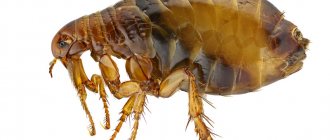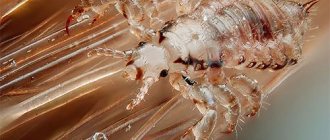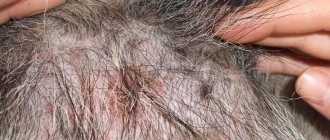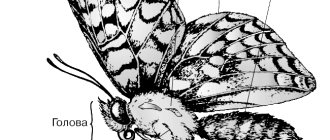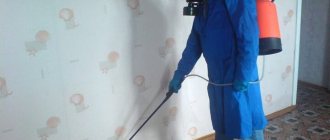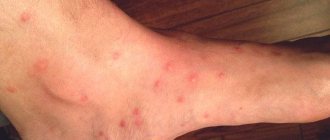- Lifespan
Fleas are perhaps one of the most famous small parasitic insects. They cause the most harm and trouble to our pets: cats and dogs, but they can also be dangerous for humans, since in some cases fleas can be carriers of dangerous diseases such as pseudotuberculosis, listeriosis, and tularemia. What are the habits of these little parasites, what does a flea look like, where does it live, how to fight fleas, read about all this further.
Description, structure, characteristics
What do fleas look like? The body length of a flea is only 1-5 mm, but sometimes females of certain flea species can be much larger, up to 1 cm, especially after intensive feeding. Due to nutrition, the size of their abdomen increases, and the flea itself, as a result, increases in size. Usually the largest fleas, measuring more than 1 cm, parasitize moose and deer.
The flea's body, consisting of the abdomen and head, is covered with a durable chitinous covering. When looking at a flea through a microscope, you can see how much the body of this insect is flattened laterally. Perhaps in some ways the flea even resembles a shrimp, only several times smaller. In fact, this shape of the flea’s body is justified by evolution itself, thanks to which the flea can easily penetrate animal fur, bird feathers, and even the folds of human clothing.
What color are fleas? The color of the flea can be reddish, yellowish, dark brown or completely black.
The flea does not have wings, and as a result cannot fly, but it jumps well. However, wings would only hinder her movement inside animal fur. The flea gets on the body of animals exclusively with the help of high and distant jumps, which are carried out due to the strong push of the second and third pairs of their legs.
The flea is also covered with numerous spines and bristles, which are scattered throughout the body, and on its head there are jagged combs - ctenidia. Thanks to this structure of the flea's body, it is very difficult to comb it out, pull it out or bite it out. It can only be destroyed by crushing it with a fingernail on a hard surface.
The flea's eyes, like those of other insects, are located on the head, and behind them there are antennae, with the help of which male fleas catch females during the mating season. These antennas are immersed in small antennal fossae.
Fleas have a piercing-sucking type of mouthparts, how does this manifest itself? The flea bites through the skin of the host (on whose body it parasitizes), widens the wound and releases saliva into it, which prevents blood clotting. Then she dives into the wound herself, trying to get to the blood vessels. By feeding on blood, fleas fill their stomach, which tends to swell greatly.
Among other things, all fleas have a special sensory organ - the pygidium, which is located in the back of their abdomen. The tactile hairs of the pygidium are capable of sensitively detecting even the slightest vibrations in the air, warning the flea of potential danger.
The female flea has reproductive organs consisting of the testicle, oviduct and spermatheca, while males have a copulatory organ - the genital claw.
How can you tell if there are fleas at home?
House fleas are not separate species. This is the name given to insects that have settled in an apartment. They are not detected immediately. To determine whether there are insects at home or not, you can conduct an experiment. You need to spread a white sheet on the floor and look at it after some time. Dark insects are clearly visible against a light background. Another sign of the appearance of “uninvited guests” are bite marks on the human body - red, slightly swollen spots that appear in the morning and are very itchy.
Lifespan
How long do fleas live? The lifespan of a flea depends on its species and habitat, and can range from several months to three years. At elevated temperatures, when the air temperature is more than 30 C, the life cycle of the blocks is reduced by 40%. And at lower temperatures, the life expectancy of a flea, on the contrary, increases as its development slows down.
How long do fleas live without an animal or, in general, without a donor? Being outside the animal's body, the flea remains without food, but since these insects are capable of not feeding for a long time, the flea easily tolerates hunger for 30-40 days. At the same time, it can live for several months, although such a starving flea reduces its activity and stops reproducing.
Features of character and lifestyle
Photo: Flea insect
Some fleas (such as rabbit fleas) are very host specific, while other species parasitize a variety of mammals. The cat flea infects not only the domestic cat, but also dogs, foxes, mongooses, possums, leopards and other mammals, including humans, if its normal hosts are not available.
Related mammals tend to parasitize fleas, which are themselves related. Thus, peak rabbits (Ochotona) living in the rocky mountains are infested with two distinctive genera of fleas that are also found on peaks in the mountains of Asia, indicating a close phylogenetic relationship between these geographically separated hosts. Bird fleas have relatively recently adapted to their hosts. They share several similarities, one of the most obvious of which is the increase in the number of ridges on the upper surface of the thorax, which serve to anchor them within the feathers.
Interesting fact: Monkeys do not eat fleas, nor do horses and most ungulates. The most parasitic group of mammals are rodents. Their habit of building nests in burrows promotes the development of flea larvae. Animals without permanent residence tend to carry fewer fleas.
Although both flea sexes feed voraciously and repeatedly on blood, they survive for varying periods of time, regardless of the host. For example, a rabbit flea can survive nine months at temperatures near freezing without feeding.
Habitats
Where do fleas live? Strong, hardy, these insects are common everywhere, even in cold
Antarctica, where they can successfully parasitize the same penguins and seals. Most of their species live in the temperate and subtropical zones of Europe, Asia, Africa, and the Americas. Fleas are active at any time of the year. They usually live near the nests and burrows of their potential donors: warm-blooded animals.
Danger to people and animals
Fleas and lice are carriers of diseases, often very serious ones.
- Lice. These bloodsuckers are divided into the following types - body, head and pubic. The body louse can be a carrier of typhus, an epidemic of which in the last century destroyed the lives of thousands of people. Relapsing fever, the plague is carried by head lice. Pubic individuals are currently at the stage of extinction, thanks to the fashion for hair removal of intimate areas. Since lice live mainly on people, they pose a danger primarily to them.
- Fleas. They are considered more dangerous than lice as carriers of infections due to their “omnivorousness”. They can feed on blood from both humans and animals. Therefore, they become infected with various diseases more often. Fleas are also carriers of helminth eggs, which easily pass into the victim’s blood when bitten by an infected insect. Fleas pose a danger to both people and animals.
Nutrition
What do fleas eat? Fleas feed exclusively on the blood of their hosts, or donors, on whose bodies they successfully parasitize. The main victims of fleas are mammals, whose life at any time of the year is connected with the presence of a shelter. But animals that live in burrows and nests only periodically are less susceptible to flea attacks. Typically, fleas do not live on the body of their owner all the time, but jump there only to feed on their blood; having had their fill, they jump into the litter of a hole or nest.
Some fleas are associated with animals that do not have permanent housing at all; these types of fleas are stationary parasites, that is, once on the host’s body, they no longer leave it. These fleas include fleas that live on dogs and cats.
Unlike
mosquitoes, in which exclusively females are bloodsuckers, in fleas, both males and females suck blood equally. The process of saturation with blood can last from one minute to several hours. Sometimes fleas are saturated with blood in reserve, significantly inflating their abdomen.
Stationary fleas have a need for regular feeding, this is another reason why they do not leave the host’s body on their own. In between meals, they wander freely in the skin of their prey.
Interestingly, most types of fleas can parasitize different animals, for example, jump from a squirrel to a dog or cat. The only exceptions are fleas
bats that require only bats as hosts.
Fighting methods
The fight against this misfortune should begin with a number of special measures that can stop the reproduction process and neutralize already born individuals. If there are animals in the house, then it is necessary to treat their fur with special products .
Shampoos and a variety of medications are sold in pet pharmacies especially for these purposes . A very good assistant in this matter is pyrethrum , which veterinarians strongly recommend treating the hair of cats and dogs.
It can also be used to treat all possible places where pests accumulate directly in the home. Folk remedies include sweeping floors with a wormwood broom . A flea collar is also actively used.
Types, photos and names
Zoologists have identified up to 27 families of fleas; we will describe the most interesting of them.
human flea
It is the most common among fleas and lives everywhere. It is brown in color and 1.6-3.2 mm long. Moreover, this flea is capable of jumping to a height of up to 30 cm and half a meter in length. Unlike other fleas, it does not have thoracic or head teeth. It can parasitize various animals, including humans (hence its name). In addition to humans, it is often found in animals that have close contact with humans: primarily in cats, dogs and
horses. It is very dangerous, as it can carry the plague pathogen and cause pulicolosis - an itchy skin lesion.
Cat flea
Despite the name, this flea lives not only on cats, but also on dogs, rodents, and many other animals, sometimes even on humans. The cat flea has a short proboscis and a flat forehead, the body length is 0.75-5 mm.
Dog flea
This flea is a close relative of the cat flea, and can also live on dogs, cats and other animals, including humans. In appearance and size it is similar to a cat flea, the only difference is in life expectancy, if a cat flea lives up to 2 years, then a dog flea lives no more than 1.5 years.
Southern rat flea
This type of flea is especially dangerous because it carries plague, mouse and rat tapeworms. It lives everywhere, but to a large extent these fleas are common in areas with warm tropical climates. Females range from 1.8 to 2.7 mm in length, males are slightly smaller: 1.4 to 2 mm. They may be light or dark brown in color. Most often they parasitize rats and other rodents, living in their burrows or nearby.
Penetrating flea
She is also the sand flea or the Brazilian ground flea. Originally from Brazil and Haiti, this flea was eventually introduced to Africa, India and Pakistan, where it successfully took root. It has an oval-shaped body and a red-brown color with a white spot in the middle. The average body length of this flea species is 1 mm, and it is capable of jumping to heights of up to 30 mm. Usually lives in the grass, from where it jumps on animals, birds and humans. Penetrates under the skin of animals' feet. A person can penetrate under the nails of his toes and fingers, and lead to inflammation, tetanus, and in especially difficult cases, gangrene and amputation of limbs.
Flea Behavior and Identification
Fleas are quite active and sense the approach of danger very well thanks to sensory organs that detect the slightest shudders in the air. This is why it is almost impossible to neutralize a flea with bare hands .
There is a high probability that it will move to another owner and continue to be saturated with his blood. We should also not forget that most fleas are not on the animal itself, but in its environment, which complicates the process of pest control.
When purchasing a drug to exterminate parasites from a pet pharmacy, do not forget to inquire about their toxicity level for the animal and check the period of its action.
As you know, it is easier to prevent than to cure. Special animal collars that are impregnated with insecticides will help you with this.
Reproduction and development
Under favorable environmental conditions, fleas reproduce all year round. At extremely low temperatures, fleas will survive without problems, but will not reproduce. Also, for successful reproduction, both partners must be well-fed; hungry fleas will not reproduce.
During sexual intercourse, the female climbs onto the male's back and pulls his genital claw into her spermatic receptacle. Interestingly, sexual intercourse in fleas can last several hours, while it takes 10-15 minutes to transfer the seed to fertilize the female.
Some time after fertilization, the female lays eggs, which pass in small portions. Typically, fleas lay 1-2 servings of 4-10 eggs per day. The process of laying eggs itself is very curious: the female forcefully pushes out the eggs, which sometimes fly considerable distances from each other. This position of the eggs makes sense, since competition between the hatched larvae subsequently decreases.
How quickly do fleas die when treated with insecticides?
After synchronous treatment of the premises and pets, flea imagoes die within 1-2 days. But the insecticide does not penetrate deep into the carpet, where eggs, larvae and pupae hide. In addition, the cocoon reliably protects the pupa from chemical exposure.
After how many days should I re-treat fleas?
When using long-acting contact preparations, adults emerging from cocoons will die within 3-4 weeks. However, over time, the properties of the chemical weaken. It is recommended to re-treat the premises after 2-3 weeks. As a rule, two or three treatments are enough to remove a colony of domestic fleas.
Life cycle
Fleas are insects with complete metamorphosis, and their life cycle consists of the following stages:
Flea eggs when looking at them through
microscopes are very similar to grains of rice.
Egg development lasts approximately 14 days. Then worm-like and translucent larvae emerge from them, still without legs. Wriggling, they climb into the litter of the owner's nest. Flea larvae feed on rotting organic matter, skin epithelium, or the remains of undigested blood in the excrement of their parents.
After three lines, the larva turns into a pupa. The pupal stage, depending on the type of flea, can last from several days to several months; in some species of fleas at the pupal stage, fleas overwinter, and emergence from the cocoon is timed to coincide with the onset of spring warmth.
Having emerged from the pupa, the adult flea first begins to search for its owner.
How long can adult fleas live without food?
After emerging from the cocoon
At home, adults newly emerging from cocoons must drink their first blood within a week so as not to die of hunger. In a number of experiments they survived longer, but two weeks is the ceiling. 95% of young hungry fleas at +24˚C and a relative humidity of 78% die in 15 days, and at +22.5˚C and a relative humidity of 60% - in 12.3 days.
Fleas that do not feed on blood survive much longer, up to 40 days, in a humid environment at relatively low temperatures. In cool, damp air (62%), young fleas will live even 70 days without animal blood. But such conditions are found only in the basements of apartment buildings, and not in residential premises.
Discarded from the owner
Once on the host, fleas immediately begin to feed. During the day, the insect doubles in size and triples the supply of proteins in the body. Once thrown from the animal, the flea loses its accumulated weight and protein supply within 12 hours. After 12 hours of fasting, death can occur as a result of malnutrition. If fleas only have access to food for 2-3 hours a day, they are malnourished.
Blood addiction threshold
When feeding on a host, at a certain point fleas pass a point at which they require a constant source of blood to survive. This is reminiscent of drug addiction. Males removed from the animal after 5 days of feeding die within 48 hours, and females die within 96 hours. Survival outside the animal increases sharply (up to 14 days) if the initial feeding period is limited to 12 hours, since in this case the dependence threshold is not reached.
Flea bites
Flea bites cause stabbing pain when the skin is pierced and a strong desire to scratch the bitten area. A characteristic swelling usually appears at the site of the bite, somewhat similar to that from a cigarette burn. After the flea has eaten and detached itself, the edges of the wound converge, preventing bleeding, and a pinpoint hemorrhage forms at the site of the bite.
The main method of protection against little bloodsuckers is the complete destruction of fleas at home + prevention from them and other possible parasites (the same
ticks) when going outdoors.
Symptoms of infection and self-diagnosis
The bites of blood-sucking parasites cause irritation and severe itching of the skin in pets, in some cases accompanied by an allergic reaction. As a result, the animal begins to intensively lick the fur, and some of the fleas are removed. Therefore, it is sometimes difficult to understand that a cat or dog is suffering from fleas - the parasites jump on the animal only while feeding.
The skin in the affected areas becomes irritated and small red bumps and crusty areas may appear along the back and neck. The hair begins to fall out more intensively, and in advanced cases, bald patches appear. Fleas are carriers of helminths, so the presence of worms in an animal's feces indirectly indicates infection by insects.
Signs of fleas on an animal.
Having appeared in the house, parasites spread throughout its territory - they hide in carpets and other woolen products. The pet cannot hide from them anywhere, and its behavior changes. Owners of a cat or dog can recognize attacks by blood-sucking insects by the following signs:
- the animal avoids its usual sleeping place;
- becomes irritable and restless;
- shakes his head vigorously;
- suddenly jumps up;
- makes plaintive sounds or growls.
You can detect insects using a white cloth and a special comb, the teeth of which are arranged in such a way that fleas get stuck in them, or a comb with fine teeth. The pet is placed or laid on a cloth and its fur is combed from head to tail.
During the procedure, either fleas themselves are found in an infected animal - brown insects with a flattened body 2-4 mm long, or their eggs and excrement, which look like a mixture of white and black grains. A drop of water should be applied to the suspicious material. If it contains flea excrement, then when wet, the black grains will turn dark red because they contain blood cells. If there are no signs of infection, but the symptoms do not disappear, you should consult a veterinarian.
How to get rid of fleas in an apartment?
If you already have these parasites in your apartment, then the best remedy for fleas will be special insecticides that can destroy fleas even in the most neglected rooms. Since fleas could not even physically eat poisonous bait, means of combating them are made in the form of sprays, powders and suspensions that affect the nervous system of fleas.
When treating a room with aerosol preparations, it is necessary to temporarily evacuate all the inhabitants of the house, and then thoroughly ventilate the room and do a thorough wet cleaning.
Among the best flea medications are:
- Raptor spray with a pleasant mint scent. It is safe and effective; usually two cylinders are enough to treat a one-room apartment.
- Sinuzan is an effective and professional remedy for fleas. Its disadvantage is the unpleasant smell.
- Biorin is a professional product that destroys not only fleas, but also other insects and parasites.
After exterminating fleas, you should definitely do a general wet cleaning of the house, and generally monitor cleanliness, since unsanitary conditions and dirt are the most favorable environment for these insects.
Where do parasites hide in the house?
To make insect control as effective as possible and quickly eliminate the problem, it is important to know which places need to be given more attention. Fleas can move throughout the home, but they usually concentrate in the areas where they are most comfortable.
This:
- upholstered furniture, mattresses;
- bed linen, towels;
- carpets, rugs (especially with natural pile), linoleum;
- fur clothes;
- Stuffed Toys;
- cracks in the floor, baseboards;
- pet bedding;
- household waste;
- any other places where cleaning has not been carried out for a long time.
Typically, insects live no higher than 1–1.5 meters above floor level. Therefore, bites on humans are most often on the legs.
Interesting Facts
- In the 17th-18th centuries, fleas were so common among the French nobility that French aristocrats even had special items for catching fleas, so-called “flea traps,” which were small boxes like a medallion with a small hole into which fleas could accidentally fall.
- It was fleas that caused terrible epidemics of bubonic plague in the Middle Ages, which claimed many human lives. The plague fleas themselves were carried by rats and mice.
- Fleas are true jumping champions among insects; the length of a flea's jump can exceed the length of the flea itself by 100 times! Only cicadas jump further than fleas in relation to body length.
- The first serious scientific study of fleas began in the 19th century. A great contribution to their study was made by a certain Charles Rothschild, a wealthy English banker and part-time entomologist. He also collected the world's largest collection of various fleas, which is now kept in the British Museum.
Why are these bloodsuckers needed?
At the moment, there are many species of fleas (Pulex irritans, Ctenocephalides felis, Ctenocephalides canis, Xenopsylla cheopis, etc.). Without these small pests, many animals would simply die out.
After all, these bloodsuckers are part of the specific food chain of various animals. Also, these bloodsuckers transfer various diseases from one carrier to another.
Thus, blood-sucking insects (fleas) are useful not for people, but for certain viral microorganisms.
The role of such a bloodsucker in nature comes down to the fact that it is a parasite. Thus, this insect shortens the life of its “carrier” (cat, dog, etc.).
In general, fleas have a positive meaning in nature, but they are more likely an epidemic. Often these small pests are the causative agents and first carriers of various epidemiological infections.
According to numerous laboratory studies by biologists, this bloodsucker simultaneously carries 30 types of specific viruses and bacteria.
Fortunately, not all such insects have the same ability to transmit various pathogens (plague, typhoid, etc.). It all depends on the diet, type and physical condition of the bloodsucker.
Video
Author: Pavel Chaika, editor-in-chief of Poznavaika magazine
When writing the article, I tried to make it as interesting, useful and high-quality as possible. I would be grateful for any feedback and constructive criticism in the form of comments on the article. You can also write your wish/question/suggestion to my email [email protected] or Facebook, with respect, the author.
Author page
This article is available in English -
Fleas.
Signs of dangerous pests and the consequences of their bites
The presence of fleas in the house can be recognized by characteristic bites , which are located not only on the head, but also on other parts of the body. Fleas bite into the skin with force, so it is almost impossible not to notice the attack of the parasite.
At the site of the bite, a red spot or blister up to 5 mm in diameter appears with a red dot in the center. In some people, insect saliva can trigger hives or allergic rashes. Bites heal in 3–5 days.
Flea bites are very itchy. By touching wounds with dirty hands, a person can infect them. When pathogenic microorganisms come into contact with the damaged epidermis, suppuration and intoxication occur.
What does a flea's mouthparts look like under a microscope?
A flea close-up is a terrifying sight. The photo shows a frontal view of the insect. The head is small and sloping. Behind the simple eyes there are antennae, which the insect retracts into special pits when at rest. Males use antennae to hold the female during mating. This structure of the head ensures that it is deeply immersed in the epidermis of the victim in order to reach the capillary. This is what a flea looks like under an electron microscope in profile.
Flea under a microscope
The oral apparatus of the piercing-sucking type is clearly visible. The upper pair of stilettos gnaws through the skin, the lower one widens the wound. The lower lip is a kind of case for the sucking proboscis. It also contains movable palps - organs of touch. From above, the oral apparatus is covered by a head plate with sharp comb-like projections - ctenidia. An enzyme secreted by the insect's salivary glands prevents blood clotting. The insect does not mask its bite with painkillers, like many blood-sucking fellows.
Flea close up
The abdomen, consisting of 10 segments, can increase as soon as the adult insect begins to feed. The fleas in the photo seem huge; in fact, the size of the flea varies from 1 mm to 5 mm, but in the females of some species the abdomen hypertrophies, and the insect can grow up to 10 mm. The largest are white fleas - alakurts. They are called this because the eggs ripening in the abdomen stretch it, making it almost transparent. Alakurts parasitize the long wool of sheep, but are found on other ungulates - roe deer, goats, gazelle, and elk.
The structural features of these blood-sucking insects also include the presence of a sensory organ characteristic only of this family – the pygidium. Localized behind the 8th segment, the pygidium is equipped with tactile hair-like outgrowths of chitin (trichobothria), which detect air vibrations and inform the insect about a threat.
Methods of movement and jumping characteristics
Fleas move in several ways. They:
- jumping;
- crawl;
- running.
Parasites cannot fly due to the lack of wings.
Jumping is the main movement option for fleas. Jumping fleas move so quickly that it is almost impossible to follow them. It seems that the insect has simply disappeared. This is understandable, because at the moment of jumping the flea reaches a speed of up to 2 m/s.
The length of a flea's jump reaches 50 cm. This distance exceeds the length of the insect's body by 120 - 150 times. The flea jumps not only far, but also high – it can cover a distance of 30 cm.
Scientists are still studying how the flea jumps. Research shows that at the moment of jumping, the insect's body contracts like a spring. Then the long muscular hind legs are used, with which the flea pushes off the surface and abruptly begins to move in the desired direction.
An interesting fact is that a hungry flea can jump non-stop for several days in search of a victim.
What does a bite entail: main symptoms
Experts have found that fleas are carriers of more than 200 dangerous bacteria and viruses. Victims of parasites may develop the following diseases:
- salmonellosis;
- brucellosis;
- Siberian plague;
- encephalitis;
- tularemia.
But most often people become infected from bloodsuckers with pulicosis, which has the following symptoms:
- enlarged lymph nodes;
- migraine;
- sleep disturbance;
- causeless irritability;
- high body temperature;
- wounds on the skin and mucous membranes that do not heal for a long time;
- rash in the area of the bite.
Preventing fleas in cats
If you have just gotten rid of annoying parasites or want to avoid their appearance altogether, you need to take a number of measures:
- Bathe your cat regularly with flea-proof shampoo and wash her bedding frequently.
- Periodically inspect the animal for parasites.
- It is not advisable to let your pet go outside, where he can meet an infected animal and pick up fleas from it. After a walk, wash your cat with anti-parasitic shampoo.
- Put a flea collar on your cat.
- Give the animal injections against blood-sucking parasites at the required intervals.


